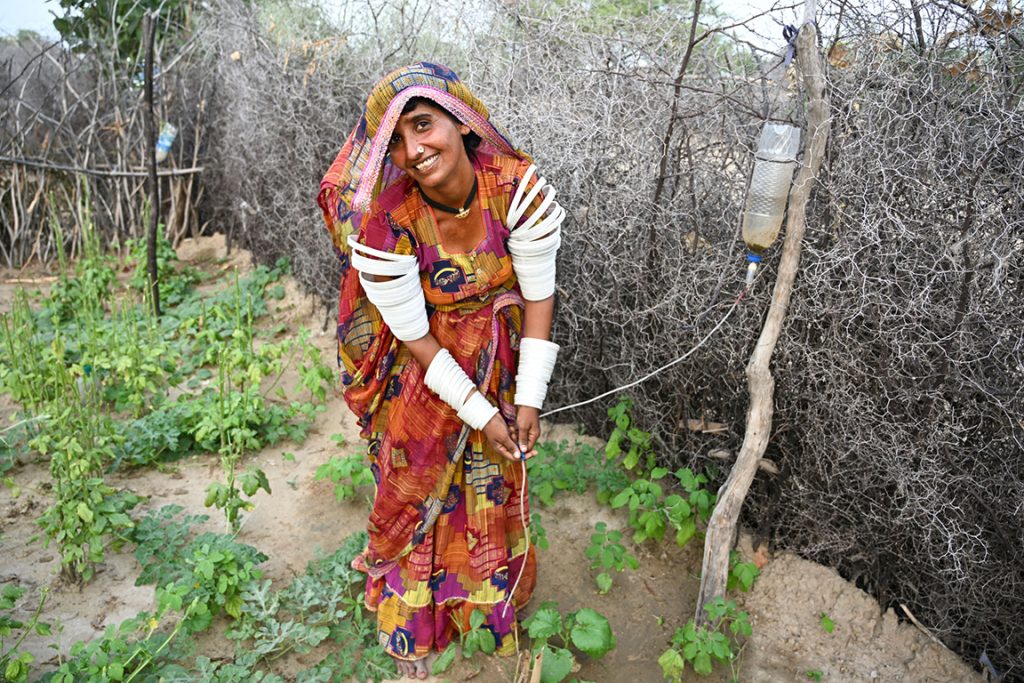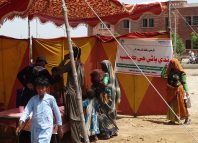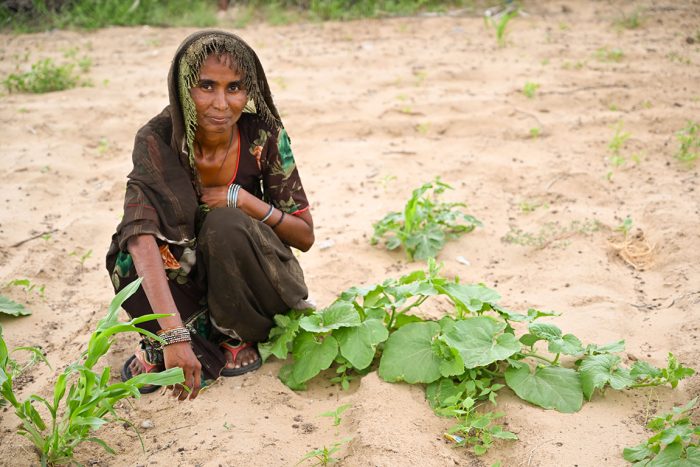From Seeds to Stews
Kitchen Gardens: A sustainable model for food security & diversity for the people of Umerkot
“We, none of us in this village, ever thought of keeping a kitchen garden. It was something beyond our thinking,” with these words Sohdi of village Charihar Bheel echoes the voice of thousands of women and men across the desert area of Umerkot. This is what they believed until Community World Service Asia (CWSA) launched the training sessions on kitchen gardening.
Now, even though they live in a sand desert, the communities of Umerkot are all farmers and livestock keepers. Their practice has long been to plough their fields in late June and sow the seeds of their seasonal crops in anticipation of the coming monsoon. For vegetables, however, they made a separate set of furrows on one side of the main field. Because the fields are outside the village, sometimes a little way off too, there was no way of watering them. Therefore, while hardy crops like guar beans, mong or millets could survive until the rains begin in July, the vegetable seeds needed watering.

Consequently, the seeds that made it through until the first shower produced a small crop of vegetables to last a few days. If the rains were good, the farmer’s family had a supply of wholesome, organic vegetables for a few weeks. And then the plants withered. That is, a farming family in Umerkot had vegetables only once a year during the first fall of summer rains. Of course there is the hardy chibhar (Cucumis melo agrestis), wild and abundant in the summer whose miniature melon-like fruit can either be stewed fresh or dried. There is also the kandi (Prosopis cinerara) tree with its leguminous seed pods that make another nourishing stew known as singri. And then, during the monsoon, the people of Umerkot have the luxury of a fine and rather abundant mushroom, even if for a short while.

This, then, is the limit of their fresh local vegetables. The other source is purchasing from the city. This is done only when someone is in town for work; to go especially for vegetables would make the purchase unaffordable. Since there is no way to stock them fresh at home, the purchase is usually for two or three days and consumed in this period before the vegetables go off. Unsurprisingly, the usual diet in Umerkot was wheat or millet flatbread with chilli paste washed down with water. Variety in diet was virtually unknown for the most part of the year.
Yet, as Sohdi says, no one ever thought of preparing a patch nearer to their home to have a regular supply of fresh vegetables.
The kitchen gardening intervention, by Community World Service Asia, Canadian Foodgrains Bank (CFGB) and Presbyterian World Service & Development (PWS&D), with relief following the drought of 2021 introduced the farmers of Umerkot to the idea nobody had thought of before: a small patch right by the house for vegetables. This is always in the charge of the woman of the household and speaking with several of them one can learn how to manage a kitchen garden for fresh vegetables: water the patch and keep it moist for three days before adding animal manure. Then prepare the furrows and plant the seeds. Flood irrigation is a wasteful idea of the past; watering should be done with a used PET1 cola bottle with its cap punctured to deliver a small stream in the root of the sprouting plant. And the kitchen garden is ready to supply vegetables two to three weeks after the sowing.

An hour distance away, in New Subani, the very vocal Dai who is a member of every committee in the village, has no doubt how well her kitchen garden serves her family. She says she planted her first patch in March 2022 with okra, chibhar, guar, cucumber, squash and zucchini. It was very fruitful and she has never looked back since. The garden sowed in March lasted until the middle of May before withering away in the arid pre-monsoon heat. “Everyday we had vegetables with our chapatti which beats chilli paste any time. And my crops of squash, okra and zucchini were so abundant, I gave away vegetables gratis to my neighbours,” she says.
According to Dai, the fear of what to feed a visitor was banished from her life after she began her kitchen garden. That year, Dai did her second batch in July. The rains were very good and her garden lasted well into August. She kept the seeds from her vegetables and with some supplied by CWSA, planted a very successful kitchen garden again in March 2023. In July, she yet again had a little garden coming along well after the first rain of the season.

Earlier, every year Dai planted a small patch of vegetables by the side of her agricultural plot. It was always a dicey business. To get some little out of it was considered good fortune, and that only when it rained on time. But the CWSA training on kitchen gardening and this idea of having the patch next to her home has made her a supplier of free vegetables to her neighbours and anyone who comes asking.
Far away in Kachbe Jo Tar, another village in the same district, school teacher Bhammar Lal Bheel tends his wife’s kitchen garden. He speaks of the joy of having fresh spinach, okra, eggplant, marrow and pumpkin and says that the variety of the menu in his home has given him more energy than he ever had. “The millet chapati (unleavened flatbread) slides down very easily when taken with a vegetable stew,” he says with a smile.
Being the man who goes frequently into town, he knows the rate of vegetables and recounts it for the listener. Two days’ worth of greens for a family of eight members like his put one back by at least PKR 800 (Approx. USD 2.75). And even then the vegetables were not very fresh. He also knows that they are treated with harmful chemical pesticides. But now with their own kitchen garden the family has fresh, straight off the stalk vegetables that are one hundred percent organic too. It is free because CWSA provided his wife the seed to augment her stock she saves from her previous garden.

Bhammar Lal produced a MUAC (Mid Upper Arm Circumference) measuring tape. He says he first of all began by measuring MUAC in his own family and was surprised by the progressive increase in size among the children in the weeks following the addition of vegetables to their diet. Then he went around the village comparing the measurements of those families with kitchen gardens with those who did not have them. “There was such a clear difference, not only in children’s MUAC, but of grown women as well. That speeded up my personal campaign to encourage more and more kitchen gardens,” he says with visible pride. “It’s the vitamins!”
Bhammar Lal says his wife participated in the CWSA training sessions and learned how to make the best of the little vegetable garden. But there are women who were not part of the training and who are not in on this little open secret. “I go around the village instructing other women on how to make a kitchen garden. And then I follow up a few days later and if they are not at it, I encourage them to at least try it out,” he says. He is happy that by his effort, there are many more kitchen gardens in the village. To paraphrase Sohdi again: everyone is happy because chapati goes down so well with stewed vegetables.

Not too far, in Rohiraro village, the ever-smiling Gauri points out one effect of the kitchen gardens that have now sprouted almost all over the village. And this may not have been foreseen by the NGO: with the vegetable patch to look after, women have not gone to ‘Sindh’ (as they refer to the irrigated districts to the west) last year and again in 2023. In consequence, children who leave school in March to travel with the family and return after the summer vacations have had two full years of education.
In Gauri’s view, the real winner is education. That is even more important than just good health.
- Polyethylene Terephthalate







